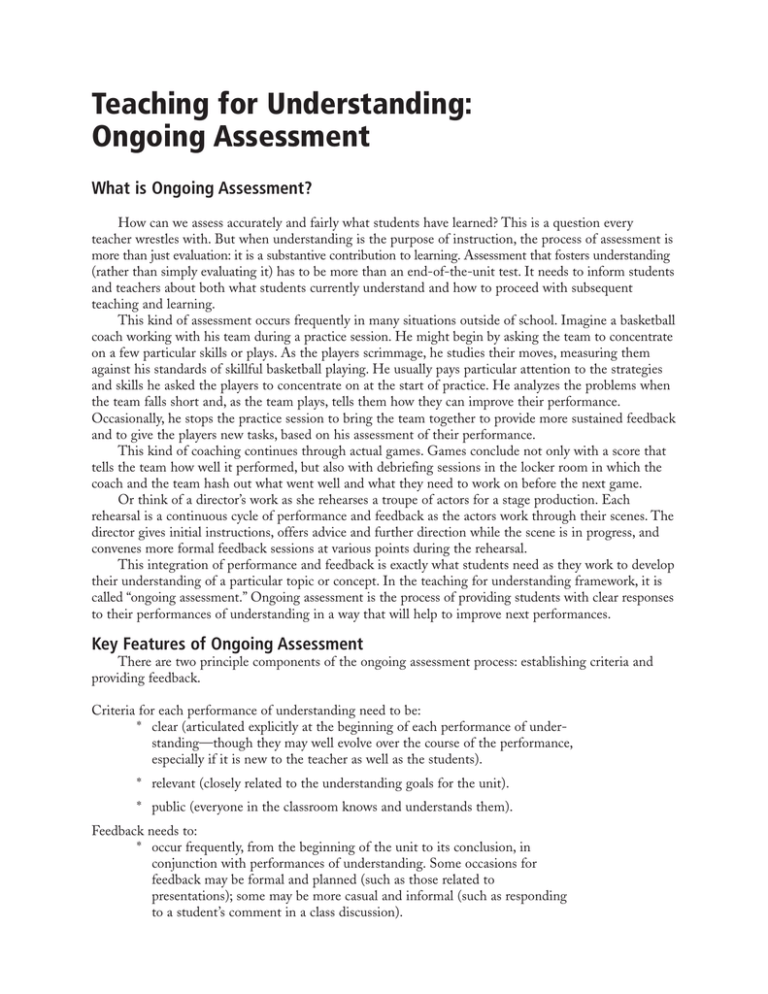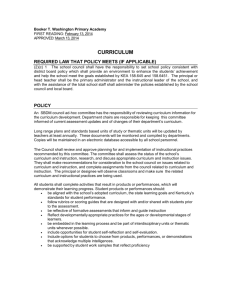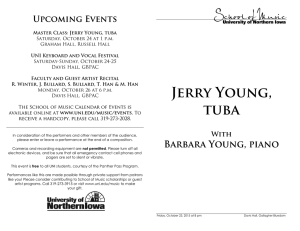Teaching for Understanding: Ongoing Assessment
advertisement

Teaching for Understanding: Ongoing Assessment What is Ongoing Assessment? How can we assess accurately and fairly what students have learned? This is a question every teacher wrestles with. But when understanding is the purpose of instruction, the process of assessment is more than just evaluation: it is a substantive contribution to learning. Assessment that fosters understanding (rather than simply evaluating it) has to be more than an end-of-the-unit test. It needs to inform students and teachers about both what students currently understand and how to proceed with subsequent teaching and learning. This kind of assessment occurs frequently in many situations outside of school. Imagine a basketball coach working with his team during a practice session. He might begin by asking the team to concentrate on a few particular skills or plays. As the players scrimmage, he studies their moves, measuring them against his standards of skillful basketball playing. He usually pays particular attention to the strategies and skills he asked the players to concentrate on at the start of practice. He analyzes the problems when the team falls short and, as the team plays, tells them how they can improve their performance. Occasionally, he stops the practice session to bring the team together to provide more sustained feedback and to give the players new tasks, based on his assessment of their performance. This kind of coaching continues through actual games. Games conclude not only with a score that tells the team how well it performed, but also with debriefing sessions in the locker room in which the coach and the team hash out what went well and what they need to work on before the next game. Or think of a director’s work as she rehearses a troupe of actors for a stage production. Each rehearsal is a continuous cycle of performance and feedback as the actors work through their scenes. The director gives initial instructions, offers advice and further direction while the scene is in progress, and convenes more formal feedback sessions at various points during the rehearsal. This integration of performance and feedback is exactly what students need as they work to develop their understanding of a particular topic or concept. In the teaching for understanding framework, it is called “ongoing assessment.” Ongoing assessment is the process of providing students with clear responses to their performances of understanding in a way that will help to improve next performances. Key Features of Ongoing Assessment There are two principle components of the ongoing assessment process: establishing criteria and providing feedback. Criteria for each performance of understanding need to be: * clear (articulated explicitly at the beginning of each performance of understanding—though they may well evolve over the course of the performance, especially if it is new to the teacher as well as the students). * relevant (closely related to the understanding goals for the unit). * public (everyone in the classroom knows and understands them). Feedback needs to: * occur frequently, from the beginning of the unit to its conclusion, in conjunction with performances of understanding. Some occasions for feedback may be formal and planned (such as those related to presentations); some may be more casual and informal (such as responding to a student’s comment in a class discussion). * provide students with information not only about how well they have carried out performances but also how they might improve them. * inform your planning of subsequent classes and activities. * come from a variety of perspectives: from students' reflection on their own work, from classmates reflecting on one another's work, and from the teacher. Examples of Ongoing Assessment Ongoing assessment needs to occur in the context of performances of understanding that, in turn, are anchored to understanding goals. Therefore, each of the examples below includes unit-long understanding goals (statement form only) and performances of understanding, as well as a description of criteria and feedback for ongoing assessment. In a writing class: Understanding goal To help students understand the process of writing an effective persuasive essay. Performance of understanding: Students write an essay in which they pick a controversial issue and argue for their personal stance on that issue. Criteria for ongoing assessment: Teacher and students co-develop the criteria for the essay. To do this, the teacher presents students with two brief sample essays written about the same issue. The first argues the thesis effectively; the other is noticeably less-well executed. By comparing the two, the students (with guidance from the teacher) generate the criteria for a good persuasive essay (a clear position statement, concrete examples to support the position, a consideration and refutation of counter arguments, and so on). The teacher copies the list of criteria for each student in the class so that they can use it in the feedback process. Feedback for ongoing assessment: Using the criteria sheet, students complete a first draft of their essay and write a short reflection assessing it. They share this draft with a classmate, who also provides a short written piece that reflects on how well the essay meets the criteria. Equipped with these two reflections, students revise their essays and submit final drafts to the teacher. Both the teacher and the student assess the final work of the essay by rating —on a scale of one to ten—how well the student achieved each of the criteria and writing a brief explanation of the rating. In a math class: Understanding goals: To help students understand percentages and their real-life uses in describing data. To help students understand surveying as tool for collecting data that can be expressed mathematically. Performance of understanding: Students develop surveys to collect information from fellow students about their health—say, the number of colds each person catches in a year—and some variable that the students think will be related to healthiness (percentage of after school time spent exercising, for example). They decide how to use graphs and charts to represent their data most effectively. (For example, eighty percent of students who report getting sick less than once a year spend fifty percent or more of their after school time engaged in some exercise.) Criteria for ongoing assessment: The teacher shares with the students a sheet that describes the two categories of criteria for their work: qualities of an effective survey and characteristics of an effective use of percentages in survey work. Feedback for ongoing assessment: Students share drafts of their surveys with one another for feedback and critique. They submit a first draft of their graphs and charts to the teacher for comment. The final draft is submitted with a self-evaluation that the teacher includes as part of their final grade. In a social studies class: Understanding goal: To help students understand various forms of government and their advantages and disadvantages. Performance of understanding: Small groups of students are randomly assigned a form of government (monarchy, oligarchy, democracy, and so on) and given a brief description of how laws are made in that government. Each student is assigned a role (monarch or president or dictator, wealthy owner of a factory, laborer living near the poverty line, and so on) within the group by drawing a slip of paper from an envelope. The group then has to decide how to levy taxes in their country, making their decision according to the form of government they have been assigned. After giving the groups some time to work through the problem, students “jigsaw” so that the new small groups are made up of one member of each of the original small groups. In these groups, they share their experiences and discuss the advantages and disadvantages of a particular approach to governance. Each student then writes a paper describing her initial group experience with the assigned government and comparing it to other groups’ governments. Criteria for ongoing assessment: Students’ final papers are assessed both on how accurately their initial groups carried out the enactment of their particular government’s decision making process and on the degree and sophistication of comparisons and contrasts they are able to make between that form of government and others. These criteria are shared with the class before they begin writing. Feedback for ongoing assessment: The teacher has each student exchange first drafts with another member of their group so they can check one another's accuracy in depicting the first small group work. She then has them share a second draft with her, so she can check their understanding of various forms of government. In cases where one (or more) of the small group seems not to have captured the essential aspects of the assigned government, she provides the students with feedback about where to find more information about that government so they can revise their work. Planning Ongoing Assessment It is usually easiest to think about specific ongoing assessment procedures in the context of performances of understanding or activities you have planned. Use your understanding goals to generate the criteria by which to assess students’ performances. For instance, if you ask students to write a paper with the aim of building their understanding of a particular concept, then the paper needs to be assessed primarily on the basis of how well they demonstrate their understanding (not primarily on whether or not they have used complete sentences and appropriate paragraphing). Build in opportunities at the beginning of and throughout a unit for assessing students' developing understanding. If assessment happens only at the end of a unit, it is not "ongoing;" it cannot help the students to develop and refine their understandings in the progress of their work. Create opportunities within performances of understanding for students to give feedback to one another and/or get feedback from you as they work. Across performances, try to balance formal and informal feedback. Also, try to allow opportunities for a variety of perspectives on assessment over the course of the unit: self-assessment, peer assessment, and your assessment of student work. Build in time to help students develop the skills they will need to provide one another and themselves with useful feedback. Self-reflection and peer-assessment does not come easily to most students, but both can be learned. Teaching with Ongoing Assessment Even if you have a sense for what the criteria for a particular performance should be, try inviting students to develop the criteria themselves by looking at models or mock-ups of similar performances. Post criteria prominently in the classroom. Help students to see how the criteria relate to the understanding goals. Model for students how to provide feedback that both tells them how well they are doing and gives them information about how they might do better. Portfolios and reflection journals can be useful tools for students to track their learning over time. Use assessment opportunities not only to gauge how well the students are doing, but also to examine and reshape your curriculum and pedagogy. Common Questions About Ongoing Assessment This kind of assessment sounds very time consuming. How do teachers manage it? Looking carefully at student work does take time, but the simple fact of the matter is, if we don’t look closely at that work, we have no idea what students are really understanding and what they are missing. And, without feedback, students have little chance of figuring out what they need to work on. On the other hand, it helps to keep in mind that, in fact, most of us are assessing our students all the time. Every time they ask a question or respond to one of ours, we are thinking about what those questions and responses reveal about their learning. The trick is to figure out how to let our students benefit from that continual weighing process and to help them understand the criteria for those assessments as well as we do. Several techniques help to make this more manageable: 1. Not every performance needs to be assessed formally. Feedback can be given verbally and informally as students work in small groups or as we lead a class discussion. 2. Keep criteria lists boiled down to just those few items that you really care about (those items stated in the understanding goals). Not only does this make the grading and feedback process easier for us, but it also ensures that students will be spending the time and energy well. 3. Take time to teach your students how to talk with one another about assessment. If everyone understands the criteria for a performance and has had practice with providing supportive critiques, the students can coach and provide feedback for one another, even if you're the one who ultimately gives the grade. What's the difference between performances of understanding and ongoing assessment? Understanding performances are the things students do to develop their understanding. Ongoing assessment is the process by which students get feedback on what they do, based on clearly articulated criteria for successful performances. It is, in essence, the process of reflecting on performances in order to guage progress toward the understanding goals. Questions for Refining Ongoing Assessment * Does it include clear, public criteria? * Does it use criteria closely related to understanding goals? * Does is provide frequent opportunities for feedback throughout the unit’s performances? * Does it provide feedback that tells students how well they are doing and how to do better? * Does it offer opportunities for multiple perspectives? - teacher assessing student - students assessing one another - students assessing themselves * Does it provide a mix of formal and informal feedback? * Are the Ongoing Assessments cycles of feedback which helps students build understandings over time? * Is there a public criteria for your Ongoing Assessments? © Tina Blythe and Associates, (1998). The Teaching for Understanding Guide. Jossey-Bass, San Fransisco. Active Learning Practices for Schools, Teaching for Understanding: Ongoing Assessment. Harvard University Graduate School of Education and Project Zero. Used with permission.

